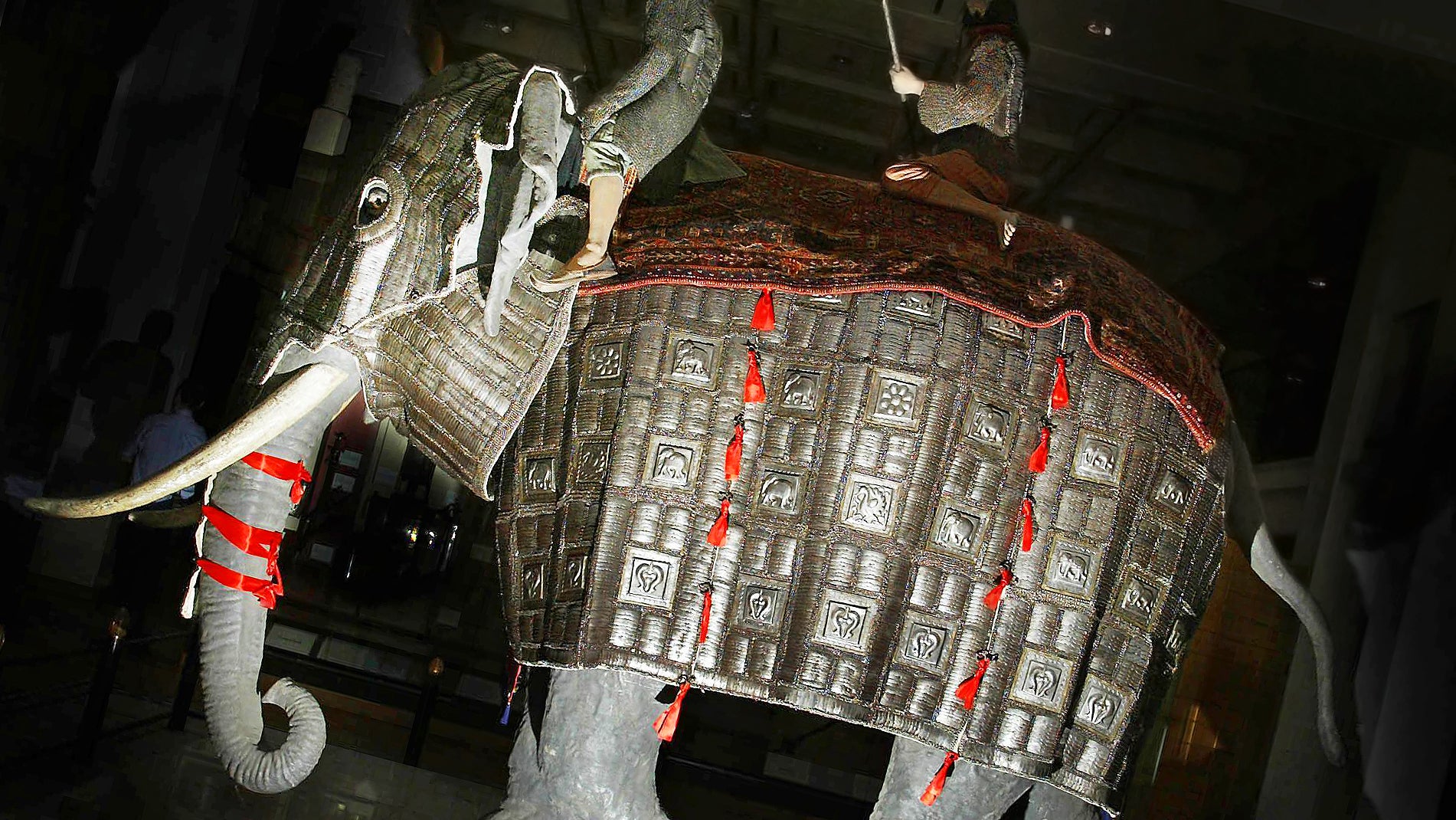Cavalry is heavily celebrated and romanticized in western culture. From the knights of Europe, to the charging forces of 19th century America, to the war in Afghanistan, the fascination with the horse as a war animal continues to this day in popular culture. But farther to the east, the war elephant reigned supreme on the front lines in some of the greatest battles in ancient history.
Something of the main battle tank of their day, these huge beasts were often sent charging towards the enemy’s lines, and unlike horses, spears and common blades had little impact on them when fighting at full tilt. To increase the survivability and improve the lethality of these creatures in combat, increasingly elaborate sets of armor were built for them, with the one above being the most extensive of its kind still surviving to this day.
The armor is displayed on a life-size elephant model in the Oriental Gallery at the Royal Armouries National Museum of Arms and Armour in Leeds. This specific set of armor was brought to Britain by the wife of the second lord of Clive, who was the governor of Madras in 1801. It was originally displayed Powis Castle before it was transferred to London Tower in 1949 for conservation. It was acquired by the Royal Armouries in 1962 in lieu of death duties.

The highly embellished metal suit, which includes elaborate depictions of various animals, was designed for an adult Asiatic Elephant in the 16th century. It emanates from Northern India during the Mughal Empire, and is made up of 5,840 individual plates weighing some 260 pounds. Part of the suit is missing, but complete it is estimated that it would be made up of a total of 8,439 metal plates, and would weigh over 350 pounds. Regardless, even in its current form it is the Guinness World Record holder for the largest suit of animal armor.

What’s not displayed, but also part of this armor set, are a pair of long, crescent shaped tusk swords (also called elephant swords) that would have been mounted on a war elephant’s partially sawn-off tusks. During a charge they would have slashed and pierced their way through whatever they came in contact with. Some armies coated these attachments with poison, making them even more lethal and instilling greater fear among the opposing army’s ranks.

The use of war elephants dates back millennia. Their use is mentioned as far back as the 4th century BC, likely originating in India. From there the use of elephants as weapons propagated through the centuries and eventually ranged as far west as the Mediterranean. The tactical employment of elephants on the battlefield played a major role in the conquests of Alexander the Great, who was so fearful of their impact in combat that he eventually commandeered some and employed them in his own ranks.
Hundreds of years later, the Romans put war elephants to use en masse during their own campaigns, including the conquest of Greece. Even as the widespread use of elephants for warfare died off in Europe in the early middle ages, farther east they remained a staple in large standing armies. It wasn’t until the introduction of gunpowder that elephants finally began to fade from militaries in Asia, but this was a slow process. In fact, President Lincoln was offered elephants to use against the Confederates during the Civil War by the King of Siam, which was politely turned down.
What seems to be the last major use of elephants on the front lines was in Vietnam in 1885 during the Sino-French War where they were used as mobile firing platforms more than anything else. But long before then, cannon fire made the lumbering beasts increasingly vulnerable during combat, which led to their tactical utility being questioned. As early as the 1500s, elephants began to disappear from major battles in south central Asia.

Traditionally speaking, the war elephant was used to charge enemy lines or to counter an impending enemy charge. They could crash through seemingly impenetrable walls of infantry, breaking a gaping hole in the enemy’s formation, with the elephant slashing with its augmented tusks, stampeding over soldiers, and giving archers a near ideal platform to pick off fighters below.
Above all else, they were major psychological warfare elements that would instill terror and the feeling of dream and hopelessness in the enemy. Their thick hides and massive size made traditional edged weapons nearly useless against them. Their unfamiliar stench could send enemy cavalry running in fear as well. They could also work as mobile command and control platforms or even to dump soldiers right into an ongoing skirmish.

Countermeasures against elephants included targeting their tusks, as cutting them off could send them running mad. The use of special javelins, fire (including igniting screaming pigs covered in oil), and eventually specially built crossbow artillery that would send an iron bolt through their thick hide were also tactics employed over the centuries to stop elephant onslaughts. Still, many of these tactics were opportunistic in nature and adding armor to elephants could help harden them from some known vulnerabilities.
A major factor that kept war elephants around so long is that they could be turned into beasts of burden when not in combat, helping to construct fortifications, bridges, and other installations, or transporting materiel over long distances. Still, they will be remembered most for their crushing impact on the battlefield.
One can only imagine how terrifying it must have been for a soldier to face down such a huge and heavily armored animal on an ancient battlefield, many of which may not have ever seen an elephant before. Not to mention how terrifying the chaos of combat must have been for the elephants themselves, which are incredibly intelligent and social creatures.
Contact the author: Tyler@thedrive.com
